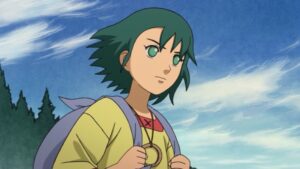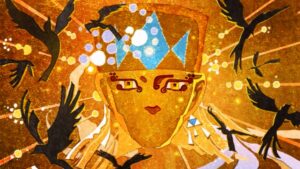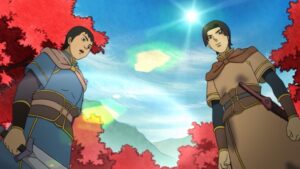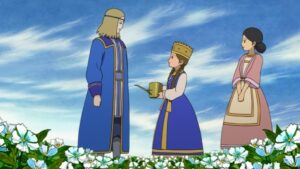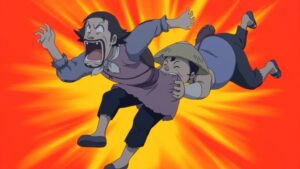Seirei no Moribito has always been one of my favorite anime. Oh times change, I grow older, new shows come out or I find old ones I had never seen. Slowly it moves down the list, falling to newcomers like Ping Pong the Animation, Mob Psycho 100 and Keep Your Hands off Eizouken. But it never really left my mind, I always end up revisiting it every few months, either looking it up on YouTube or listening to its OST. So imagine how pleasantly surprised I was to learn that Moribito’s author, Nahoko Uehashi, had gotten another adaptation, animated once again by studio Production I.G. It is that show, Kemono no Souja Erin, directed by Takayuki Hamana and with music by Masayuki Sakamoto, a story about a young girl struggling to survive and keep to her ideals in a country at war with itself, that we’ll be talking about today.
Be warned, this review contains minor unmarked spoilers for Kemono no Souja Erin. It also contains major spoilers in some sections however these will be heavily marked to avoid accidents.
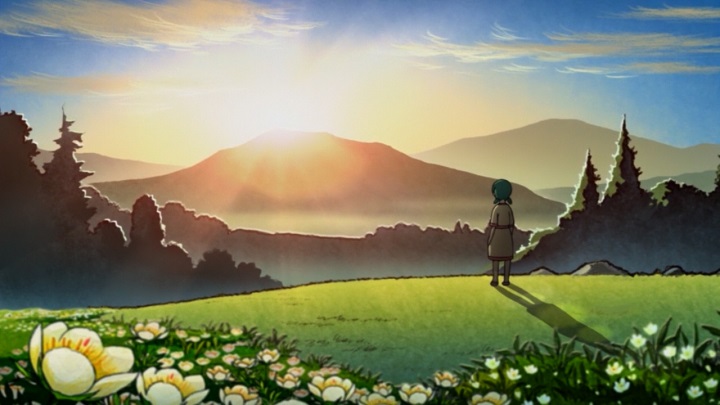
Production
Starting off let’s talk about Erin’s production. Erin could best be described as “subdued”, or “subtle”. It’s best scenes, the ones that define it and stick in my head even now, tend to be these wide sweeping landscapes. The kind that are just as much about the world as the characters within it, where Yasunori Miyzawa’s stunning background art can be used to its fullest effect. I’m not joking when I say the Erin’s landscapes, their use of color and lighting as well as how they establish this world and those who live in it, are the visual highlights of the show. Combine that with some stellar direction from Takayuki, knowing when and how to use it, and it becomes clear that when Erin wants to it can look great. There’s only one issue in all of this: Erin isn’t what I could call a “kinetic” show.
What does that mean? Simply put, Erin isn’t a show that moves much. And when it does, I wouldn’t say it looks very good. Despite the simpler, more rounded designs compared to Seirei no Moribito, Erin doesn’t really use them all that much. Characters are static, they slide across the screen, and the few animations we do get are reused over and over again. More often than not Erin simply cuts away, giving us an artistic shot of a river or falling leaves letting only the sound guide us as to what is happening, before cutting back to the aftermath. The sole exception to this are these hyper-stylized cave painting-esque sequences that, though rare, look absolutely gorgeous. They don’t come up often, but when they do they are quite memorable. In general though, if what you want is bombastic styled action, Erin isn’t going to fulfill that for you.
That’s ok though, because that isn’t what Erin is about. If you’re looking for an action heavy show about a girl getting revenge, or overthrowing a kingdom, go find something else. Because Erin isn’t that. Instead it’s about a young girl trying to find a way to live how she wants in a world defined by rules and restrictions. It’s a storybook tale, greatly accentuated by the rustic and painterly art style. About the only pure “negative” with Erin’s production to me, something that isn’t just a stylistic choice, is it’s reuse of scenes/flashbacks. This gets a bit egregious, as across its 50 episodes you’ll probably watch 4-5 episodes worth of flashbacks, if not more. That’s not bad for a show of this length, with this much content, and it’s something we will talk about more coming up. But it is something you will notice as you watch.
All in all, Erin is neither a particularly kinetic, nor even particularly good looking, show. It’s obvious just by the art style, from the softer faces and simpler designs, that this was made for a younger audience. And it doesn’t make great use of that simplicity either, only occasionally bothering to animate them at all. But that’s offset largely the strong direction, gorgeous backgrounds and a well realized setting that makes you think this world could really exist. Erin is not a powerhouse, a technical wonder, a visual spectacle… But neither is it falling apart at the seams, taking you out of the scene with bad compositing or Berserk 2016 CGI. It does what it needs to do, nothing more nothing less. And considering the quality of it’s writing, that’s good enough for me.
Setting/Narrative
Speaking of the writing, this is where Erin starts to take off. The story can be split into 2 halves, one centered on our titular Erin and her struggles to live a life she can be proud of, the other on the geopolitics of the world around her. As far as Erin is concerned, she’s great! Her growth from a small child to a fully fledged adult, her struggle to hold true to her ideals in a world built in opposition to them, even something as simple as going to school, is handled expertly. She goes from this young, naïve child who wants nothing more than to learn everything she can to a resolute adult who refuses to compromise even in the face of death. As far as character arcs go, and as the titular character hers is the central one of the story, it’s great!
The issue is with the second half. For while Erin’s world is beautiful and detailed, often taking time to establish things like the ecology of a region or the biology of its unique animals, It spends very little time working through the actual politics of the region. We get a solid setup, one region defending another from war but eventually being looked down on as second class citizens while the other becomes a sort of “idyllic paradise” without conflict. And this does payoff at moments in other characters arcs. But the actual politics of it all largely go ignored, skipping forward every few episodes rather than being given the attention it deserves. This is despite the fact that over half the cast is directly involved in said politics. Erin instead chooses to spend time on, well… Erin.
This is important because Erin’s story eventually intersects with the political one, merging the two plot threads together. And rather than elevate this story of political tension, it instead brings Erin’s story down to its level. Because its so under baked and underexplored, Erin’s own narrative arc has to be dumbed down to fit in beside it. This is exacerbated by Erin’s copious use of flashbacks and exceptionally slow pacing in the 2nd half. I’m talking like… upwards of 1/3rd of an episode. It would be one thing if these were flashbacks to episode 5 in episode 45. But often it’s of scenes from 3-4 episodes ago. It’s as if the show doesn’t trust its audience to remember things. Had Erin instead taken this time, as well as sped up the pacing a bit, and put it towards the political subplots, it could have easily made both shine.
Simply put, the narrative of Kemono no Souja Erin is consistently solid about 75% of the time. It starts well, it ends decently, the middle bit has highs and lows, just be prepared for copious use of flashbacks and to not see some members of the cast for large stretches of episodes. So long as Erin is your favorite character, you’re basically guaranteed to have at least a decent time. As for the rest of the cast? Well lets talk about them.
Characters
By and large the cast of Kemono no Souja Erin is solid. I would say there is a core group of 5 that were pretty good, Erin among them. These 5 basically carry Kemono no Souja Erin on their back. We already talked about Erin above, so as an example lets take a look at Soyon, Erin’s mother and one of the most important characters in the entire show. She’s really only around for a few episodes before Erin goes on her journey. Yet her influence is felt all the way until the end, her words of wisdom and the way she lives her life being something Erin constantly thinks back on all throughout the series. And as Erin learns and grows and reflects, it gives us new ways to look back on Soyon in turn. It’s like a feedback loop of character development, it’s great.
Sadly this sort of symbiotic narrative only really occurs within this core cast. For the rest, they aren’t particularly engaging at all. Nasan? He shows up in maybe 4 episodes out of 50, and only has one meaningful scene in the entire show. Seimiya? Perhaps by the end she becomes interesting, but for the most part she’s more of a plot device than a character. The other kids/staff at Kazalm, the school? They only exist to fill space and make the place look like it isn’t empty, none of them really matter in any meaningful way. And that’s not even getting into Mokku and Nukku, two “comedic” characters who don’t belong in general. They remind you this is, in some small way, a kids show. And they do it through terrible jokes and basically bringing down almost any scene they are in.
All in all, the most important members of Erin’s cast are good enough to make you overlook the rest of them. At times you might see an inkling of a plot thread, a hook for another character that you wish would be followed, and then be disappointed when it isn’t. I know I was with characters like Nugan or Tomura. But these go by and are forgotten quickly as Erin’s own story continually marches onwards to greater and greater heights. Is it the best ensemble cast I’ve ever seen? No. But the ones that matter are good enough, and that’s good enough for me.
OST
Finally we come to the OST, the part of Erin that I am most conflicted on. Created by Masayuki Sakamoto, responsible for the Magical DoReMi OP arrangement as well as the OST of Dangaizer 3 OVA, Erin is really his only full-length TV anime credit, and it sort of shows. You see, the best way I can describe Erin’s OST is, in a word, Inconsistent. Clashing. Dissonant. Most of the OST is filled with these beautiful, ambient tracks that suck you into the world, fitting it’s older, almost medieval or feudal, setting quite well. I’m talking about the old, traditional sounds of “Kodai no Kamigami“, placing you right in the middle of a story of legend. The hidden depths behind “Kiriku“‘s strings, or the rustic whimsical warmth of “Ashita“. These are all great, and they flesh out the setting just as much as Yasunori Miyzawa’s backgrounds do.
Meanwhile on the other side, Erin’s OST is filled with these harsh sounds of electric guitars and conflict. Some, like “Semari Kuru Kiki“, are fine. Still loud and repetitive, but it manages to build towards something interesting by the end. Others though, such as “Konmei” and “Sentou” just feel out of place. They clash not only with the rest of the OST but with the show itself. They sort of fit, in that they have a lot of energy and violence in them, matching some of the more brutal/warlike scenes. But even then I think Erin has done better with tracks like “Oujuu Sentou“, or even “Shuugeki“. And that’s not even mentioning the outright mediocrity of tracks like “Shinen” and “Touda“. For all the great ambience it has, Erin has it’s fair share of screwups as well.
Even with those mistakes though the best is yet to come. Erin’s OST is at it’s strongest with the vocal tracks. The haunting vocals of the “Wajyaku Song“, the beautiful lullaby of “Yoake no Tori Vocal” and the somber majesty of “Taizai no Uta” are without question the standout tracks of the entire show. Which is a good thing, because you’re going to be hearing them a lot. This is the metaphorical fly in the soup of Erin’s OST. It takes the good tracks, the vocals and ambients, and runs them into the ground. They play over and over and over again. You won’t mind the first few times, but by the end you’ll be begging for Erin to switch things up just a bit.
Simply put, when Erin’s OST hits, it hits hard. Not only in the music but in how it’s used as well. However between Erin’s length and its reuse of music, those moments became fewer and farther between as the show went on for me. I would still say it’s good, with some special mentions for the majestic “Oujuu Hishou“, the inquisitive “Aru Dekigoto” and the sheer Celtic fun of “Ginyuu Gakudan“. But it’s stretched thin by a 50 episode runtime and the electric guitars it occasionally employs are a loadstone around its neck. Trim some fat, pick and choose your favorite tracks, and you’ll have a good time. It just falls a bit short as an individual piece in a larger package.
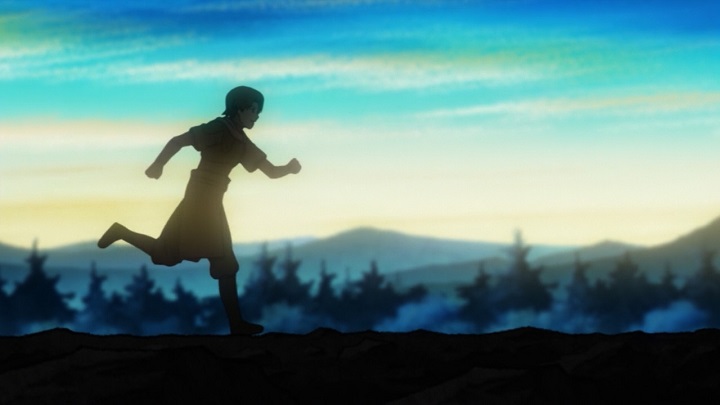
To Long? Or Not Long Enough?
With that we come to the personal section of the review. This is where I dive into spoilers, ramble a bit, and just try to let you get to know me as an individual and my experience with the show. This is a no holds barred spoiler territory, so only enter if you either don’t care or have watched the series. That out of the way, lets jump into something contentious shall we?
So what do I mean by this title? Well my experience with Kemono no Souja Erin was an inconsistent one. I watched 4 episodes a week for about 3 months, trying to get it done in a single season. So you could say the way I watched it was… accelerated, in a way, though I know many people watch far longer anime far faster. Still, point is this was a reasonable pace. So anytime Erin started to feel slow, like a lot of the middle bits where she’s in Kazalm and going through all of her school work, it often picked back up a bit in the other 3 episodes I watched that week. This makes it hard to call Erin “slow” for me, because it certainly didn’t feel it watching at that pace. But looking back on the experience… I can’t help but think it was.
The best reason I could come up with for this odd contradiction is the way Erin’s story is structured. Split into two, Erin trying to figure out how to live her life after the death of her mother and reconciling the fact that her morals are at odds with her society, and a political coup/reformation subplot going on in the background, Erin really favors the former. A good 80% of the runtime of the show is just spent on Erin getting by in her day to day life. That sounds fine until you look at what it does to the latter part of the story, the political subplot, which ends up feeling half baked and underutilized. So anytime we jump back to it, Erin has to speed run us through the political shifts, making things feel fast. But then we go back to Erin and she’s just… hanging out.
Yeah, Erin hanging out is nice. Her time spent with Lilan at Kazalm, bonding with her, figuring out how to fly, accepting that she’s going against the codes and that what she’s doing might one day result in her death, is all great. It’s really introspective. But it doesn’t mesh well with the high-stakes politics that have the fate of the Kingdom hanging in the balance. Even more so when said politics don’t really get to slow down and take on a personal edge until the very end, when Erin finally starts interacting with those in charge. Like… Why is Erin meeting Seimiya, princess to the throne and current leader of the nation, for the first time in episode 47 of 50. Why does she never meaningfully meet or interact with Shunan, the de-facto ruler of her home region, despite eventually throwing away her vow to never involve Beast-Lords in human conflicts to save his life?
This is where the title of this section comes in. It feels to me like Kemono no Souja Erin either could have cut the political subplot entirely, focusing purely on Erin’s own place within this larger system, and thus shortened the show by like 10 episodes. Or it could have tacked on another like… 20 episodes, and taken the time to truly flesh out the politics of this world and why Erin is getting involved in them at all. Either one could have worked, either one would have made for a better viewing experience. It’s not like Erin’s setting isn’t strong enough to support the extra episodes, it easily could, and reducing the scope should be even easier. But instead Erin chose the middle ground, ending up with a half-baked political backdrop that dragged both the pacing and Erin’s own story down with it.
A damn shame, because when Erin is firing on all cylinders, it’s absolutely great.
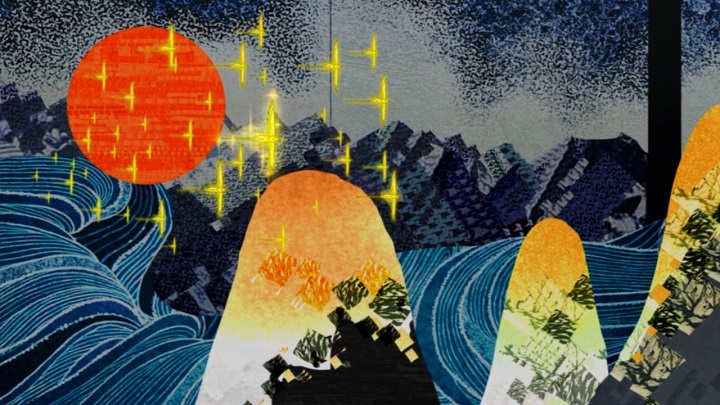
Conclusion
All in all, I went into Kemono no Souja Erin with some pretty big expectations. Seirei no Moribito is my jam, I love it, I wish we got more anime like it. And while I wasn’t expecting it to live up to that standard, it still fell a tad short of what I was hoping for. It’s larger scope caused it to lose focus at times, and its attempt to target a younger audience clashed a lot with the more serious story it was trying to tell. I mean seriously, there were a lot of fart jokes and physical comedy from the Mokku/Nukku pair. Even with these issues however, the core of Kemono no Souja Erin remains strong. Erin’s personal journey and the beautiful, detailed setting that surrounds her. These sucked me in. So even if I was taken out of the experience at times, and the ending felt a bit lacking, I would still recommend it to people. Just… Don’t go in expecting anything life changing.
And with that another season of Throwback Thursday is over! Thank you all for reading. Apologies this took so long, I came up with a case of writers block about halfway through and just couldn’t figure out how I wanted to proceed/phrase things. Still, I got it done eventually, and that’s what matters. You know what else that means though? That’s right, it’s time to announce our next season! This one’s a treat, it’s been on the poll for over a year, and I know at least one reader has been trying their damnedest to make it win. That’s right, it’s the 1999 mecha from Studio Sunrise, directed by Kozuyoshi Katayama with music composed by Toshihiko Sahashi, The Big O! We’re going to be covering both Seasons 1 and 2, since it was originally meant to be a single 2 cour series. Because I need a small break, our first post will go up on September 28th, right before the Fall season. I remember watching this on Cartoon Network of all places when I was a kid, so I’ve been looking forward to it for a while. I hope you have been too. See you there!

